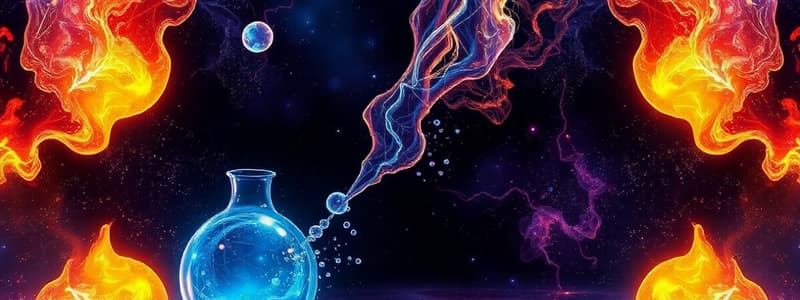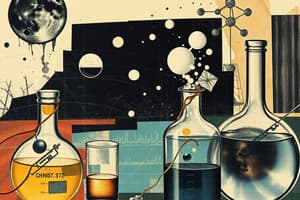Podcast
Questions and Answers
What happens when a gas is cooled during the process of condensation?
What happens when a gas is cooled during the process of condensation?
- The gas particles evaporate and spread out.
- The gas particles remain unchanged.
- The gas particles gain energy and disperse.
- The gas particles lose energy and group together to form a liquid. (correct)
What effect does heating a solid have on its particles?
What effect does heating a solid have on its particles?
- They instantly convert into gas without melting.
- They become more compact and form a solid.
- They lose kinetic energy and become immobile.
- They vibrate more, leading to expansion until they melt. (correct)
How does the kinetic theory of matter explain the behavior of gas particles when heated?
How does the kinetic theory of matter explain the behavior of gas particles when heated?
- Particles compress and decrease in kinetic energy.
- Particles remain stationary with no change.
- Particles lose energy and move closer together.
- Particles gain kinetic energy and move more freely. (correct)
What determines the boiling point of a liquid?
What determines the boiling point of a liquid?
What occurs when the air inside a hot air balloon is heated?
What occurs when the air inside a hot air balloon is heated?
What best describes the shape and volume of a solid?
What best describes the shape and volume of a solid?
Which state of matter can be compressed the most?
Which state of matter can be compressed the most?
During which process does a liquid change to a gas at a specific temperature?
During which process does a liquid change to a gas at a specific temperature?
What happens to particles during melting?
What happens to particles during melting?
How does the freezing point of a substance compare to its melting point?
How does the freezing point of a substance compare to its melting point?
What conditions favor quicker evaporation of a liquid?
What conditions favor quicker evaporation of a liquid?
Which property is true for both solids and liquids?
Which property is true for both solids and liquids?
What defines evaporation when compared to boiling?
What defines evaporation when compared to boiling?
Flashcards are hidden until you start studying
Study Notes
States of Matter
- Three main states: solid, liquid, and gas.
- Solids have fixed shape and volume, high density, are incompressible, and cannot be poured.
- Liquids have a fixed volume but take the shape of their container, less dense than solids but denser than gases, are slightly compressible, and can be poured.
- Gases have no fixed shape or volume, low density, are highly compressible, and can be poured.
State Changes
- Melting: Solid to liquid; requires heat energy increasing kinetic energy; occurs at the melting point (m.p.).
- Boiling: Liquid to gas; requires heat forming gas bubbles; occurs at the boiling point (b.p.).
- Evaporation: Liquid to gas at the surface; occurs below the b.p. over a range of temperatures; faster with larger surface area and warmer temperature.
- Freezing: Liquid to solid; reverse of melting; occurs at the same temperature as the m.p.; requires a decrease in temperature.
- Condensation: Gas to liquid; occurs on cooling over a range of temperatures; particles lose energy and clump together.
Kinetic Theory of Matter
- Heating substances increases particle kinetic energy (thermal energy converted to kinetic energy).
- Heating a solid increases vibration until it melts, then further heating expands the liquid until boiling occurs.
Heating and Cooling Curves
- Graphical representations of temperature changes during heating or cooling. (Note: Specific details of curve shape not provided in text)
Hot Air Balloons
- Heated air expands, decreasing density and causing the balloon to rise.
Gas Temperature and Pressure
- At constant volume and amount of gas: higher temperature means higher pressure.
- This is because heated particles gain kinetic energy, hitting container walls more frequently and forcefully.
Studying That Suits You
Use AI to generate personalized quizzes and flashcards to suit your learning preferences.




